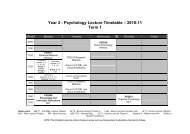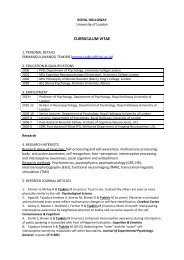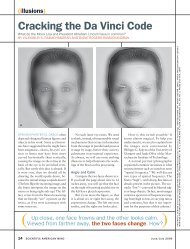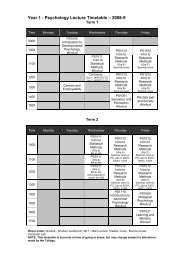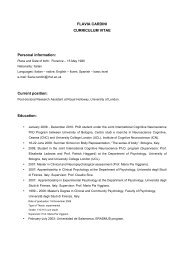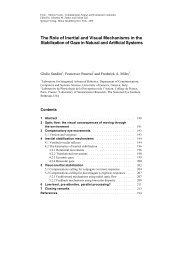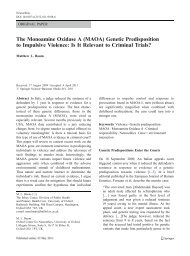Sensation, Perception, Action â An Evolutionary Perspective ...
Sensation, Perception, Action â An Evolutionary Perspective ...
Sensation, Perception, Action â An Evolutionary Perspective ...
Create successful ePaper yourself
Turn your PDF publications into a flip-book with our unique Google optimized e-Paper software.
<strong>Sensation</strong>, <strong>Perception</strong>, <strong>Action</strong> – <strong>An</strong> <strong>Evolutionary</strong> <strong>Perspective</strong>Chapter 3Vision 1: Brightness‘Loss’, Bridget Riley, 1964, private collectionBlack, white, and shades of grey in static images are the most basic local stimulusproperties that the visual system encodes from the environment – and yet they cangenerate a rich world of perceptions, as so effectively demonstrated by Op Artists.chapter3-v4.doc Page 1 of 22 01/10/2009
OverviewThe physical luminance of the light emitted or reflected by an object or surface isconverted into perceived brightness in the visual stream. This mapping of the outsideworld on mental representations is the result of neural encoding strategies that reduceredundancy and enhance local contrast. Such processing mechanisms lead to illusions,which often are interpreted as ‘errors’ of representation, but equally can be used as a toolto understand the workings of the brain. Brightness contrast illusions are revisited as astarting point to look at the encoding of light intensity in static images as basic visualprocessing – seeing bright and dark is arguably the most ordinary task for the visualsystem. Perceived brightness serves as an input to many other steps of visual informationprocessing, and as such has a fundamental importance for more complex tasks like threedimensionalshape or face perception. Neural encoding through opponency filters explainsthe resolution of spatial detail in spatial frequency channels, and also gives initial clues forthe function of contrast enhancement, redundancy reduction and image compression.These filters therefore can be well understood as a product of the evolution of optimalfilter mechanisms. More complex brightness phenomena, such as the conservation ofuniform shades of grey perceived within regions enclosed by uninterrupted boundaries,give some initial indication about higher-level processes beyond the initial filtering stage,in particular a filling-in mechanism that is needed to reconstruct the brightness for uniformsurfaces. Finally, it will be shown that in less trivial configurations, including theappearance of transparent surfaces and shadows, the visual system provides effective toolsto extract the information from images which is most relevant for meaningful interactionwith the surrounding world.Simple visual stimuliMany readers, I presume, would be most interested in questions about perception that arerelated to high-level interactions of humans, like the one raised at the end of chapter 2:how can we perceive, interpret, and understand the mysterious smile of Mona Lisa? Wehave seen in chapter 2 that a dense network of serial and parallel information processing isthe basis of visual perception, converting images of the visual field to retinotopicrepresentations of image features (‘neural images’): the three-dimensional environment iscaptured as flat two-dimensional (2D) images in two eyes and then the information isprocessed along the visual stream in a set of brain regions (see figure 3.1). The variousanalysis steps in the visual stream, in the eyes of an engineer, reduce the information in thestimulus and extract the relevant aspects for any particular task, such as face perception,and the recognition of facial expressions. In this framework, the retina works like a CCDcamera with some initial data compression, the optic nerve serves as highly parallel databus, and after a relay station in the LGN the information is distributed across at the earlyareas of the visual cortex for initial image analysis and storage (Hubel and Wiesel 1979;chapter3-v4.doc Page 2 of 22 01/10/2009
van Essen et al 1992). In particular, area V3 is generally thought to be concerned with therepresentation of form, area V4 serves the representation of colour, and area V5 isspecialized for motion processing (Zeki 1993).PCTCOCLGNONFigure 3.1: Processing in the visual stream. The visual scene is captured by theleft and the right eye and transmitted through the optic nerve (ON) and theLateral Geniculate Nucleus (LGN) into the occipital cortex (OC), from whereit is distributed into various parts of the parietal (PC) and temporal(TC)regions of the cortex. In this network of serial and parallel processing,different components of the incoming information (features) are dealt withseparately, to be later recombined (in a process call ‘feature binding’ bypsychologists, or ‘data fusion’ by engineers) to form unitary perceptions for arange of high-level processes, such as recognition, decision making, or motorplanning and control. (see Colour Plate II.1)Given the complexity of the underlying information processing stream, and of theinteractions between the brain regions involved in such processing, searching for anunderstanding of how we can read Mona Lisa’s smile is like searching for a needle in ahaystack. In chapter 1 it was argued that the key to understanding perception and brainfunction is to dissect complex problems into simple steps. A quick look at imagereproduction technologies can give some clues to how the richness of a visual scene canbe reduced to simple representations, thus providing less information whilst retaining thecore of an image. Line drawings, or etchings (each image point is black or white, carrying1 bit of information) were the traditional means of picture reproductions in books.Photography started with grey-level pictures (in digital images usually encoded with 8 bitschapter3-v4.doc Page 3 of 22 01/10/2009
per image point, or pixel), went on with colour images (usually 24 bits per pixel), and ledto cinematography, sequences of moving images (whereas a still photograph can be storedusing a couple of hundreds of Kilobytes in compressed format, a movie requires a manyMegabytes, and a high-capacity DVD as storage medium). Therefore, in an attempt toreduce the complexity of image processing under investigation, in the first instance (i) werestrict our analysis to static images (motion will be covered in chapter 6) and (ii) focus ongreylevel images, ignoring colour (covered in chapter 4).The Op Art image of Bridget Riley on the frontpage of this chapter gives an indication ofhow rich perceptual experience can be in absence of colour or movement. In AkiyoshiKitaoka’s collection of simple static patterns (Kitaoka 2002) you can admire the manyfacets of such images, how they trick the eye, and see how they are augmented by theaddition of colour. When studying the perception of brightness, we therefore will haveanother, and a closer look at a number of illusions. Illusions are often regarded as failuresof the sensory system to provide a veridical representation of the outside world – but wewill see that they do provide crucial pointers towards understanding the mechanisms of itsinformation processing mechanisms. In this context, illusions are a key to reality!Descriptors of greylevel imagesLet us start with a brief look at the physics of the intensity of light entering the eye. Lightcan either be emitted by an object, such as a candle or a lightbulb, a it can be reflectedfrom a surface, such as a sheet of paper in sunlight. The amount of visible light that comesto the eye from a surface is called ‘luminance’, whereas the amount of light that is shiningon a surface is called ‘illuminance’ and the proportion of light reflected from a surface iscalled ‘reflectance’ (see figure 3.2). These purely physical properties can be measuredusing physical devices, such as a luminance meter that measures light intensity, or talliesthe number of light particles arising from a small region of a scene. Perceptually, there isan interesting difference between the direct appearance of a surface and its physicalproperties. Perceived luminance, or the perceptual correlate of the light that arises from asurface, is referred to as ‘brightness’, whereas perceived reflectance, or the perceptualcorrelate of the light that bounces back from an illuminated surface is referred to as‘lightness’. A piece of white paper looks white in the sunlight, and it also looks white inmoonlight, despite the fact that there is much less amount of light coming from its surfaceto enter the eye. There would be no difficulty for a human observer to notice thedifference of brightness under these two illuminations, and still the piece of paper wouldbe recognised as white rather than grey – which is a surface property independent ofillumination (Gilchrist 1979). We will return to this interesting aspect of the visual system,which is referred to as ‘brightness constancy’, when looking at shadows at the end of thischapter.chapter3-v4.doc Page 4 of 22 01/10/2009
ightnessluminancereflectanceilluminanceFigure 3.2: The physics of light intensity, as seen by the eye. Light emittedfrom an object (light bulb) or reflected by a surface (sheet of paper in sunlight)is entering the eye, giving rise to a luminance distribution which is perceivedas brightness; the object property that determines the relationship betweenilluminance – the amount of light hat falls on a surface – and the amount oflight reflected from this surface, its ‘reflectance’ is perceived as lightness(white or grey paper).When it comes to perceiving brightness, perhaps the most basic question is how manydifferent shades of grey a human observer can discriminate. The answer commonlyoffered to this question, based on discrimination thresholds for boundaries between similarshades of grey at different base levels, is that we are able to discriminate about 5000shades (4096 different levels could be encoded with 12 bits of information). Notably, thisis much more than the 256 grey levels provided by a typical computer screen, or an 8-bitdigital image, the typical bitmap format.Figure 3.3: <strong>Perception</strong> of brightness. In the grey wedge on the left side,ranging from white to black (surrounded by a frame of opposite polarity) ahuman observer can discriminate approximately 5000 shades of grey, about 20times more than the levels provided by a typical 8-bit image: boundariesbetween areas of a single unit difference (1/256 of range) are visible, as can beseen by close inspection of the set of four squares on the right.chapter3-v4.doc Page 5 of 22 01/10/2009
This observation raises a number of scientific questions. What is the best description, andneural representation, of a greylevel stimulus? In chapter 2, we have seen that neuralencoding strategies emphasize luminance changes. Indeed, the most efficient descriptionof brightness does not relate to absolute levels of grey, but to differences betweenneighbouring regions, or contrast. It will shown in the following how these mechanismsaffect brightness perception. We will ask what is the relationship between objective(physical) luminance and subjective (perceived) brightness, can we interpret the visualsystem as measurement device similar to a ruler which is used to measure length. Thesimple statement about ca. 5000 discriminable levels of brightness is an oversimplificationbecause brightness is not perceived in a linear fashion, which means that equal steps ofluminance do not lead to equal steps in brightness. Instead, larger luminance differencesare needed at high average luminance levels than at low average luminance levels, in orderto perceive a difference in brightness. This fundamental relationship between the intensityof a stimulus and the smallest difference between two different intensities that can bediscriminated, is a very common property for all kinds of sensory systems and can begenerally described by ‘Weber-Fechner Law’, which claims that the proportion of changeneeded to detect an intensity step is approximately constant, later refined as ‘Stevens’Power Law’ (Stevens 1961; Stevens 1970). Based on this observation, we can get abetteridea about the metrics of brightness, i.e. how the 5000 visible shades of grey are mappedon a luminance scale? Because the smallest visible steps do not have the same size, such ascale is non-linear, unlike the linear scale of a ruler, where a millimetre covers exactly thesame distance at 1 cm as at 1 m, for instance. Such scaling extends the overall range ofluminance levels that can be discriminated, the so-called ‘operating range. In manytechnical devices, such as video monitors, this nonlinear behaviour is incorporated in thedisplay by means of ‘Gamma-correction’.The next basic question is related to the spatial resolution of the human visual system:how much spatial detail can we see? Usually, you would not be able to see individualpixels on your computer or television screen (typically 1028 by 768 pixels), but I you usea lower screen resolution (640 by 480 pixels) or a larger screen, you will see that it ismade up of small image points, or pixels, if you get close enough. This ‘spatial resolution’of the visual system can be investigated systematically by line patterns, or gratings (seefigure 3.4). It is important to note that increasing or decreasing the viewing distancechanges the number of lines that fill a degree of visual angle. The number or gratingcycles in a degree of visual angle (cycles/deg) is called by physicists and engineers ‘spatialfrequency’. The reason why you take a closer look of an image or an object when youattempt to see its fine spatial detail is that the visible detail is limited by resolution of thevisual system, in points per degree (or cycles/deg), and by reducing viewing distance youare growing the size of the image (or the cycles of a test pattern), as sketched on the rightof figure 3.4. When our eyesight gets worse, for instance in old age, it means that theresolution is reduced, and we need magnifying glasses to recognise fine detail, or readchapter3-v4.doc Page 6 of 22 01/10/2009
small texts. <strong>An</strong> optometrist or ophthalmologists using standardised tests to measure visualacuity, and 100% visual acuity corresponds to the resolution of approximately 50 cyclesper degree (Adams et al 1988; Westheimer 1984).Figure 3.4: <strong>Perception</strong> of spatial detail can be tested with textures or linegratings of increasingly fine grain, usually measured as spatial frequency(number of lines, or grating cycles per degree of visual angle). Looking at thepage from a distance of 80 cm, at which each of the four squares (14 x 14 mm)covered with gratings has the angular size of ca. 1 deg, the 4 gratings have aspatial frequency of 4, 8, 16 and 32 cycles/deg. If you increase your viewingdistance further, at some point the fine gratings blur into a grey field and areno longer visible: this is your resolution limit. The sketch on the right showshow spatial frequency of a grating image increases with viewing distance: the10 degrees of visual angle between the two yellow lines is filled with 5 gratingcycles (i.e. 5 cycles/deg) at the smaller viewing distance, and 10 grating cycles(i.e. 10 cycles/deg) at the larger viewing distance.Again, there are a number of scientific questions to be asked. How can spatial detail bedescribed, and what is the metric of such detail? As mentioned above, for simple gratingsa straight forward measure of spatial variation is the number of cycles per degree, orspatial frequency. It turns out that this is a very general and useful measure becausephysicists use a mathematical framework, Fourier Theory (Bracewell 1986), to composearbitrary spatial patterns from a combination of sinewave gratings. Whereas a psychologystudent not necessarily needs to understand workings of Fourier Theory, it is important tonot that it is very common to investigate the function of the sensory systems withsinewave gratings and to express its performance in terms of frequency. In the case ofspatial vision this is spatial frequency, measured in cycles/deg (Campbell and Robson1968; Watson et al 1983). What are the experimental approaches to investigate the spatialproperties of the human visual system? For instance, we can measure detection thresholdsfor gratings at different contrasts, or how well different gratings can be discriminated.Starting from this, the performance of less simple stimuli can be determined, and byapplying Fourier Theory mathematical models for the processing of arbitrary patterns canbe developed (Wilson 1991). In the nervous system, the tuning of individual neurons tochapter3-v4.doc Page 7 of 22 01/10/2009
spatial frequency can be determined and compared for a range of neurons and brainregions (Tootell et al 1981). This brings us back to the simple receptive field structures ofretinal ganglion cells introduced in chapter 2, which already show size, or spatialfrequency, tuning. Each neuron in the early visual system has characteristic spatialfrequency tuning, where the optimum frequency corresponds to the receptive field size (cf.figure 2.16). Groups of neurons with different optimum frequencies cover the full range ofspatial frequencies visible to the human observer, the so-called Contrast-SensitivityFunction (CSF, see figure 3.5). The universality of such neuronal properties, and thepower of this approach, led to scientific discussions whether this is a complete picture ofearly visual processing, and whether the visual brain can be understood as a ‘Fourier<strong>An</strong>alyser’ (Maffei and Fiorentini 1973; Ochs 1979).CSFsensitivityf1f2f3f4spatial frequencyFigure 3.5: Schematic sketch of the contrast sensitivity function (CSF, blackline), which represents the sensitivity of the human visual system for gratingswith variable spatial frequency. It can be understood ass the combination of aset of neurons tuned to different optimum spatial frequencies, f1 – f4 (colouredlines), or spatial frequency channels.The fundamental concept: filteringWhether or whether not the brain can be regarded as Fourier analyser, there is a bulk ofexperimental evidence (Campbell and Maffei 1974) that visual function can be explainedto a large degree by spatial frequency channels that transmit and represent fine- to coarsegrainversions of an image, which are processed, stored, used in separate neurons. Suchfilter mechanism are interpreted as a property emerging from the receptive field structureof sensory neurons, which are organised in parallel sets not only for spatial frequency(figure 3.5), but equally for other properties, such as colour, orientation, or velocity (seechapter 2). When the action of sensory neurons is described as such filtering - what doeschapter3-v4.doc Page 8 of 22 01/10/2009
this mean in more conceptual terms? The parallel sets of neurons are interpreted as patternanalyzers, which are organised as filter banks operating in the visual stream. The size andstructure of receptive fields determines the optimum size, or spatial frequency, of encodedstimulus, which is then described as the filter mechanism processing only a selection ofthe information available. To understand the function of such spatial frequency channels atan intuitive level, they can be compared to a simple mechanical system – a gravel pit. Inthe sorting engine of the gravel pit, mixed sediments which were dug up from a river bed,are separated into materials of different grain: sand, pebbles, and rocks. A simple way ofdoing this is involves sets of sieves which allow material of a particular grain pass (i.e.,filters), whereas larger grain is retained in the flow (see figure 3.6 left). At the end of suchprocessing the different components included in the original mix can be collected inseparate containers, which then contain material of a particular grain.absandgravelrocksFigure 3.6: Filtering. (a) Think of the brain as a gravel pit: when the sortingengine is fed with a mix of rocks (blue disks), pebbles (green), sand (red),different grains are separated by a set of sieves which act as a filter – anddifferent grains can be collected in different containers. (b) In the same way,think of the visual stream in the brain as a set of filters (spatial frequencychannels, indicated by concentric receptive fields) that separate features ofdifferent spatial scale (or size) – and image representations with coarse (bluediscs) to fine spatial grain (red dots) are generated in the brain. (see ColourPlate II.2)In the same way, in the visual system parallel sets of receptive fields are operating toseparate different spatial frequency components from that are contained in the retinalimage. Through this filtering the visual scene is analysed and represented in a set ofdifferent spatial frequency channels (see Wilson 1991): Fourier analysis. At some laterstage of the visual stream the information from these separate representations need to bechapter3-v4.doc Page 9 of 22 01/10/2009
combined, together with other image features such as colour or motion, to deliver a unitaryand rich percept – therefore, as will be discussed in the final section of this chapter, suchFourier analysis is a good description of the early stages of visual systems, but does notcapture all aspects of visual perception.Illusions as key to realityWhen was the last time that you were sitting on the train, waiting for it to leave the station,and when looking out of the window at the train right on the next track you got theimpression that your train started moving – only to notice a few seconds later that you arestill waiting at the platform, and that it was the other train which started to move? Quiteoften, your eyes are tricked when looking at the surrounding world, and you have torealise that your senses do not provide you with reliable or veridical information about theoutside world, but generate perceptual illusions. Painters, when trying to provide‘realistic’ representations of the world, are using a bag of tricks to create such illusions.For instance, in order to create an impression of depth on a flat canvas, the theory ofgeometric perspective and shading has been systematically developed and exploited sincethe Renaissance in Western Visual Arts (Gombrich 1977). Op Artists in the second halfof the twentieth century started experimenting with ‘optical illusions’ created in simpleline drawings or colour patterns (Riley 1995; Wade 2003). With the introduction ofcomputer aided editing and animation techniques, in the 21st century the art form ofcinematography reached new levels of presenting augmented, puzzling, or impossible –but visually absolutely convincing – worlds (just think of the special effects in movies likeHarry Potter or Lord of the Rings). Even life television broadcasts should be watched witha certain level of scepticism (remember the fireworks in the opening ceremony of theBejing Olympics?). Furthermore, illusions and other visual puzzles are frequently used inadvertising, which may be less surprising in view of the fact that the reality of a product israrely what customers want to buy.The important thing to notice is that we are constantly exposed to illusions, and that oursenses do not tell us in a reliable way what exactly is out there (Gregory and Gombrich1973). Whereas we usually think that we should only believe what we see, we also couldarrive at the conclusion that we never should believe what we see (Coren and Girgus1978; Marshall 1987). Although this suggestion may be rather sobering, or perhaps evenirritating, there is something very exciting about illusions: whilst puzzling our minds,these phenomena tell us a lot about how our brain works. In fact, visual illusions are rarely‘optical’, and don’t trick our eyes, but reflect how our brains are processing visualinformation – and for the very same reason illusions play a major role in the scientificstudy of sensory systems. So what can we learn from illusions about visual informationprocessing? In science, minimal stimulus configurations are essential to study perception.Figure 3.7 shows a famous example of a very simple drawing that generates an illusion,the ‘Kanizsa triangle’. We see a white triangle in front of three lines and three discs, andchapter3-v4.doc Page 10 of 22 01/10/2009
sometimes perceive the triangle brighter than the background – this is referred to asillusory or ‘subjective’ contours (Kanizsa 1976).Figure 3.7: ‘Illusory’ Kanizsa Triangle. What looks like a bright triangle infront of three disks and three lines radiating from the image centre, in fact is apattern of three short lines and three disk sections (‘pacmen’) oriented towardsthe centre.Using illusions generated by such simple stimuli as a guidance to understand the visualsystem, two fundamental approaches to understand illusions have been. On one hand, wehave supporters of ‘Gestalt Psychology’ who interpret illusions as reflection of perceptualorganisation (Kanizsa 1979; Koffka 1935). Within this conceptual framework, perceptionsare understood as unitary experiences emerging from and going beyond the components ofa stimulus: “the whole is more than the sum of parts”. In cases like the illusory triangle,the perceptual system chooses the best, simplest and most stable shape, according to theGestalt law of ‘Praegnanz’. More about this can be found in chapter 13. On the other hand,illusions are understood as by-products of the processing mechanisms underlyingperception (see chapter 2), which under some specific conditions lead to discrepanciesbetween the physical stimulus and its mental experience that could be regarded asrepresentation ‘errors’. In the last decades a wealth of evidence has been accumulated ofproperties of individual cortical neurons that can account for the perceived illusion ofsubjective contours (Paradiso et al 1989; Peterhans and von der Heydt 1991). Thisphysiological approach is complemented by computational modelling, formalising theoperations carried out by the neurons along the visual stream (Marr 1982). Illusions tell usa lot about the mechanisms of visual information processing.chapter3-v4.doc Page 11 of 22 01/10/2009
a b cd e fFigure 3.8: A zoo of brightness illusions. Top row: (a) simultaneous contrast –the brightness of the square is influenced by the shade of grey in thebackground, see chapter 2; (b) Mach bands – a dark vertical line and a brightvertical line are perceived when luminance starts and ends to increasegradually from one low level to high level; (c) grating induction – the greyhorizontal stripe in the centre appears to be modulated in brightness in reverseto the vertical gratings above and below. Bottom row: (d) partitioned Koffkaring – simultaneous contrast; (e) open Koffka ring – in a single object crossingthe background luminance border, simultaneous contrast breaks down and aunitary brightness is perceived for the whole object; (f) Craik-Cornsweetillusion – the vertical region in the centre looks brighter than the left and rightregions, although they only differ in the boundary regions but not in themiddle.Some of the challenges for such an information processing approach is illustrated by someexamples from the ‘zoo of brightness illusions’ shown in figure 3.8. In the top row of thisfigure some examples are shown of how the perceived brightness at a given locationdepends on its neighbourhood, like the simultaneous contrast illusion presented in chapter2, and similar effects in Mach bands (Ross et al 1989) and grating induction (Blakesleeand McCourt 1997). The bottom row of this figure shows some examples of how theperceived brightness of a clearly outlined surface tends to be uniform, such as the Koffkaring (Koffka 1935) or the Craik-Cornsweet illusion (Cornsweet 1970). The functionalchapter3-v4.doc Page 12 of 22 01/10/2009
significance, and the co-operative relationship between the processes of contrastenhancement and filling in, will be discussed in the two next sections.Contrast enhancement in brightness encodingIn chapter 2 it was demonstrated that opponent filtering, as generated by the lateralinhibition mechanisms of centre-surround receptive fields, generates minimum andmaximum responses at luminance boundaries and discards average luminance. Thisphenomenon of contrast enhancement is illustrated schematically in figure 3.9: theperceived brightness profile at a luminance boundary is generated through the opponentintegration mechanism between the excitatory centre and inhibitory surround of aconcentric ON-centre receptive field.+10inputintensity0-1abperceivedprofileFigure 3.9: Contrast enhancement (similar to figure 2.17). (a) Opponent ONcentrereceptive fields – shown as simplified opponency model (cf. figure 2.9)with a central excitatory (light and saturated green) and a surroundinginhibitory (red, pink) sub-region – at a different spatial positions of a patternwith a prominent luminance step; reduced response (0) in coherently dark andbright areas: excitation and inhibition cancel each other; negative response (-1in arbitrary units) at dark side of boundary: more inhibition than excitation;positive response (+1) at bright side of boundary: more excitation thaninhibition. (b) schematic sketch of the encoding of a luminance step function(intensity function, black line) is encoded through such opponency operatorsinto a profile encoded in a activity profile which corresponds to the perceivedcontrast enhancement. (see Colour Plate II.3)The same action of opponent receptive fields can account for illusions with less simplepatterns, like the multiple luminance step function shown in figure 3.10a. Although eachof the five vertical bars has a constant luminance, they are perceived as darker on the leftchapter3-v4.doc Page 13 of 22 01/10/2009
than on the right. This can be easily understood as the influence of the contrastenhancement at each luminance step as illustrated in figure 3.10b.inputintensityabperceivedprofileFigure 3.10: What you have is not what you see. The multiple intensity stepfunction of the stimulus pattern (a) is transferred by the boundary contrastenhancing opponent receptive fields such that at each level of the luminancesteps the grey seems to be brighter at the left boundary than at the rightboundary (b).The very same organisation of receptive fields which can be interpreted as coding strategyto amplify luminance differences across contours also operates in two spatial dimensions.The famous ‘Hermann Grid’ shown in figure 3.12a is made up of a regular pattern ofblack squares separated by small white regions (‘edges’). At the intersections of verticaland horizontal edges grey blobs are perceived, as long as they are not in the centre of thevisual field. In the visual field centre the intersection is projected on the fovea, the retinalregion of highest spatial resolution, where receptive fields are smaller and don’t match thesize of the white regions as is necessary for the explanation of the perceived grey blobssuggested in the next paragraph.In figure 3.11 a neural explanation is provided for the grey blobs appearing in theintersections of the white edges. In opponent filters (ON-centre-OFF-surround receptivefields), larger parts of the inhibitory surround are stimulated in the intersections of theedges, as compared to the white edge regions between the intersections, which explain theapparent reduction of brightness seen as grey blobs. This simple, schematic considerationdemonstrates how the contrast enhancement delivered by opponent filters operates in twospatial dimensions, leading to a strong brightness illusion in the Hermann grid. <strong>An</strong>interesting amplification of this illusion is the ‘scintillating grid’, a quite recent discoverythat raises interesting new questions about the underlying brain mechanisms (Schrauf et al1997). Obviously the explanation put forward here is a very idealised picture, an despitechapter3-v4.doc Page 14 of 22 01/10/2009
the simple explanation of the illusory grey blobs, there are other aspects which are in wantfor an explanation: The opponent filter mechanism would predict darker regions close toboundaries of the squares than in the middle of the squares, but each square appearsconstantly black. Additional aspects of image encoding that can explain this effect will bediscussed in the next section.0 - 0 = 00 - 1 = -14 - 2x1 = 2a b4 - 4x1 = 0Figure 3.11: (a) can you see grey spots in the white intersections of lines ofthis ‘Hermann Grid’? (b) Opponent receptive fields – shown schematically asin figure 3.9 – at a different spatial positions of the Hermann grid wouldgenerate no response within the black squares (top left: no stimulation ofexcitatory and inhibitory regions), and a smaller response in the intersectionsof the edges (bottom right: full excitation and inhibition) than in the edgesthemselves (bottom left: full excitation, some inhibition). However, for thesame reason the squares should be darker in regions close to the white edges(top right: some inhibition, no excitation). (see Colour Plate II.4)Image compression in brightness encodingRevisiting the variety of simultaneous contrast illusion between regions and at luminanceboundaries (see figure 3.8) in the context of the observation made for the Hermann grid(figure 3.11) that each black square appears uniformly black, leaves us with a smallparadox. The simple opponency mechanism discussed so far explains how the luminanceof the background affects the brightness of the grey square in the foreground of figure3.8a, and the underlying lateral inhibition would predict a particular enhancement ofluminance borders, because the modulation of activation from nearby regions should bechapter3-v4.doc Page 15 of 22 01/10/2009
largest at a luminance step. However, whilst such a contrast enhancement is perceived forthe multiple luminance step pattern shown in figure 3.10, it is not visible at the boundariesof the squares in figure 3.8a or figure 3.11 – the squares clearly have the same brightnessin the complete area surrounded by the luminance border. A similar uniform level of greyis perceived in the open Koffka ring shown in figure 3.8e, where the simultaneous contrastillusion that is visible in the partitioned ring (figure 3.8d) breaks down for a coherentshape crossing a luminance boundary in the background. This discrepancy suggests thatthe operation of simple receptive fields does not provide a full explanation of how weperceive brightness, and perhaps – not surprisingly – some additional, higher levelmechanisms need to be considered. Considering the limitations of the most simple modelswill bring us back to the fundamental questions of how perceived features reflect physicalproperties, and what the function (‘purpose’) of opponency encoding might.inputintensityencoded profileperceivedprofileFigure 3.12: What you have (black input intensity) and what you see (greenprofile), in this example, is not what you what you should see if simpleopponency filtering (symbolised by blue arrows) would be the only encodingmechanism in the visual stream (red encoded profile) – a region of uniformluminance embedded in dark background should have enhanced contrast in theborder regions and reduced brightness in central region (compare with figures3.9 and 3.10, for instance).This discrepancy between filtering expectation and the observation of uniform grey levelsinside borders can be best seen for the dark-bright-dark profile shown in figure 3.12: theexpectation for the encoded profile, if the neural image generated by opponency filtering,would show strong contrast enhancement at the luminance boundaries, and very similaractivation levels in the inner regions of the brighter and darker sections. Because theexclusive encoding of spatial changes through opponent processes removes redundantimage components that do not contain information, it can be interpreted as an effectivechapter3-v4.doc Page 16 of 22 01/10/2009
image compression strategy. When no signal is transmitted for regions without luminancechange, and information only is encoded at luminance boundaries, the information aboutthe uniform luminance level between such boundaries is no longer represented. The factthat for the stimulus illustrated in figure 3.12 perception is dominated by a clearly outlinedregion of enhanced brightness therefore raises the question of how the average luminancelevel of objects is reconstructed in the brain. There could be various possible mechanisms,such as combining information from different spatial scales, which could support such areconstruction process. The observation that the enclosure of an image region is soimportant for performing uniform brightness (see figure 3.8d & e) led to the proposal of acortical ‘filling-in’ mechanism by which regions that are surrounded by clear boundariesassume the same brightness (Pessoa et al 1995). The result of such a reconstructionmechanism, which also can account for the uniform black squares in the Hermann grid(figure 3.11) is illustrated in figure 3.12 and 3.13.physicalencodedreconstructedinputintensityencodedprofileperceivedprofileabFigure 3.13: (a) The discrepancy between physical luminance profiles (blackline) and activity profiles as encoded by opponent filters (red) is compensatedby filling-in mechanisms that reconstruct the percept close to the originalprofile for the stimulus illustrated in figure 12 (green). (b) Craik-Cornsweetillusion. The physical luminance profile (black line above the stimulus pattern)of this stimulus is characterised by contrast edges of opposite sign withoutchanges of mean luminance – rather different from the luminance steps shownin (a). Filling-in mechanisms, however, generate a reconstructed profile (greenline below stimulus pattern) that resembles that in (a), which explains theillusory perception of a bright region embedded in a darker background.In essence, a filling-in mechanism reconstructs the redundant image regions by assumingthat regions enclosed by contiguous boundaries originally have the same intensity. In viewof such processing one could expect a stimulus that has a physical profile, which lookslike the encoded profile that only indicates luminance borders without any change ofaverage luminance, would lead to a very similar encoded profile and after thereconstruction should be perceived like a change of mean brightness. This effect is nicelychapter3-v4.doc Page 17 of 22 01/10/2009
demonstrated by the Craik-Cornsweet illusion (Cornsweet 1970) illustrated in figure3.13b. The central area appears brighter than the regions on the left and right, although thephysical luminance is identical in the centre and the peripheral regions, and is changingonly in the visible boundary regions. This illusion demonstrates the ‘filling in’mechanism: surfaces between boundaries are apparently filled with uniform brightness.Note that this is an ‘inverted’ illusion, where the perceived brightness profile isreconstructed from an ambiguous luminance profile, assuming certain properties of theoutside world like uniform coloration. The Craik-Cornsweet illusion demonstrates that ifin the attempt to reduce redundancy only changes intensity are encoded, uniformproperties of the physical properties need to be assumed between such changes in higherlevelinterpretation from sparse data. In consequence, subtle gradients are ignored.Advanced brightness perception: Does the brain know the laws of physics?The Craik-Cornsweet illusion is a first indication that in perception the relation betweenphysical properties and internal representations can be non-veridical in such a way that themost likely surface property is recovered. When a not perfectly flat sheet of paper that isplaced on a black background is illuminated from the side, for instance, the uneven papersurface will show slight variations of luminance - shading. Still it will be interpreted not asa piece of paper with faint grey stains but as perfectly white, the visual system reconstructsthe uniform white surface property between the strong luminance boundaries. Weencounter capabilities of the visual system like this, which go beyond the most basiceffects of visual encoding covered so far, in a range of contexts that are related torecognition of objects and making them available to interaction. Three examples of suchphenomena are described briefly to close the chapter with a wider perspective, which willfurther expanded in chapter 13.Looking through a transparent surface, like tinted glass or wrapping paper, is a notuncommon situation that changes the luminance (or colour) of all objects behind thetransparent material. When reading a newspaper whilst wearing dark sunglasses, however,you don’t get the impression that it is printed on grey paper (and just from wearing pinksunglasses you will not get the impression you are reading the Financial Times).Somehow, therefore, the brain is able to account for transparency. At the top of figure3.14a you see a light grey rectangle that is partially covered by a slightly darker,transparent rectangle. When looking at this image you would not interpret it as a threeadjacent shapes covered with three different paints, which is however the preferredinterpretation as soon as the figure is disintegrated into three separate shapes (bottom of3.14a). The perception of transparency is a very powerful tool for the visual system thathelps us to recognise physical properties of the world surrounding us (Metelli 1974).In the Checker Shadow Illusion (figure 3.14b) a diffuse shadow is cast over a regularpattern of dark and bright tiles, which changes the physical luminance of individualelements considerably. In our internal representation, however, the surface is still coveredchapter3-v4.doc Page 18 of 22 01/10/2009
with dark and bright tiles. This leads to the effect that two tiles that are perceived asbelonging to the set of bright and dark tiles, respectively, actually have the same physicalluminance. Once again, it seems as if visual system uses good knowledge of the laws ofphysics, and by realising that a shadow is cast over the tiling pattern is able to retrieve thesurface properties – in this case the colouring of each tile, independent of illuminationcondition – of objects for the internal representation of the outside world. It is important tonote that it is the intrinsic properties of objects what is important to understand andremember, and that this goes far beyond just taking and storing images (Adelson 2001).AABBabcFigure 3.14: Higher-level aspects of brightness perception. (a) Transparency:when 3 shapes covered with a particular combination of grey (bottom) arearranged in a special way (top), transparency is perceived. (b) CheckerShadow Illusion: perceived brightness in regions of a regular tiling pattern thatare overcast by a shadow differs from the physical luminance of these regions:tiles A and B (red labels) have the same luminance but differ in perceivedbrightness (©1995, Edward H. Adelson) (c) The Corrugated Plaid Illusiondemonstrates that a similar difference of brightness for areas of identicalluminance (regions A and B, red arrows) can be perceived in the absence ofexplicit shadows as well, if they seem to be exposed to different illumination.When thinking about the mechanisms for this correction of perceived brightness, apossible candidate could be to detect the shadow and then subtract its contribution to theillumination of the tiles, and thus recover the original luminance of each tile. TheCorrugated Plaid Illusion, shown in figure 3.14c, demonstrates that a similar difference ofbrightness for rectangles of identical luminance (indicated by red arrows) can be perceivedin the absence of explicit shadows as well. Here it seems to be the three-dimensionalinterpretation of the image as a folded set of squares painted with different greys which iscrucial for the illusion, which might be related to an implicit reduction of illumination onthe seemingly downward facing surface region. When the set of squares is perceived asfolded horizontally such that the two rectangles appear to sit on the same plane, luminancechapter3-v4.doc Page 19 of 22 01/10/2009
and brightness both are identical. Whereas one might think that this illusion could suggestthat the brain somehow has to reconstruct some rather complex variations of surfaceorientation and lighting conditions, there are proposals how the same behaviour can bemodelled with some rather simple and pragmatic computations (Adelson 2000).Take home messages• visual information is re-organized, compressed, and categorized by parallel andhierarchical processing mechanisms to encode information efficiently in the visualstream• the encoding of levels of grey in static images is one of the most basic tasks performedin the visual stream, determining perceived brightness• opponent filters encoding by centre-surround receptive fields is a crucial strategy toenhance local contrast and remove redundancy, and crucial for brightness perception• opponency can account for a number of illusions such as simultaneous contrast, butadditional mechanisms (like filling-in) are required to deal with other aspects ofperception• illusions often are explained as high level mechanisms that construct solutions topuzzles; many illusions are a consequence of basic information processing strategies,others require higher-level mechanisms that are helpful to reconstruct the most likelyproperties physical objectsDiscussion Questions• How many different shades of grey can humans discriminate? How does this compareto technical systems?• Describe the action of concentric receptive field, and how they can act as spatialfilters.• What is meant by cortical ‘filling-in’?• Discuss the phenomenon of transparency in the context of brightness representation.chapter3-v4.doc Page 20 of 22 01/10/2009
ReferencesAdams A J, Wong L S, Wong L, Gould B, 1988 "Visual Acuity Changes with Age: SomeNew <strong>Perspective</strong>s" American Journal of Optometry and Physiological Optics 65403-406Adelson E H, 2000 "Lightness <strong>Perception</strong> and Lightness Illusions", in The New CognitiveNeurosciences Ed M S Gazzaniga (Boston: Boston) pp 339-351Adelson E H, 2001 "On seeing stuff: the perception of materials by humans andmachines", in Proceedings of the. SPIE Vol. 4299, Human Vision and ElectronicImaging VI Eds B E Rogowitz and T N Pappas pp 1—12Blakeslee B, McCourt M E, 1997 "Similar Mechanisms Underlie Simultaneous BrightnessContrast and Grating Induction" Vision Research 37 2849-2869Bracewell R N, 1986 The Fourier Transform and its Applications (Singapore: McGrawHill)Campbell F W, Maffei L, 1974 "Contrast and Spatial Frequency" Sci.Am. 231 106-114Campbell F W, Robson J R, 1968 "Application of fourier analysis to the visibility ofgratings" J.Physiol. 197 551-566Coren S, Girgus J S, 1978 Seeing is Deceiving: The Psychology of Visual Illusions(Hillsdale: L. Erlbaum Ass.)Cornsweet T N, 1970 Visual <strong>Perception</strong> (Orlando: Academic Press)Gilchrist A L, 1979 "The <strong>Perception</strong> of Surface Blacks and Whites" Scient.Am. 240 88-97Gombrich E H, 1977 Art and Illusion (Oxford: Phaidon)Gregory R L, Gombrich E H, 1973 Illusion in Nature and Art (London: Duckworth & co.Ltd.)Hubel D H, Wiesel T N, 1979 "Brain Mechanisms of Vision" Scient.Am. 241 130-144Kanizsa G, 1976 "Subjective Contours" Scient.Am. 234 48-52Kanizsa G, 1979 Organization in Vision. Essays on Gestalt <strong>Perception</strong> (New York:Praeger Publishers)Kitaoka A, 2002 Trick eyes (Tokyo: Kanzen)Koffka K, 1935 Principles of Gestalt Psychology (London: Routledge)Maffei L, Fiorentini A, 1973 "The visual cortex as spatial frequency analyser" VisionResearch 13 1255-1267chapter3-v4.doc Page 21 of 22 01/10/2009
Marr D, 1982 Vision: A Computational Investigation into the Human Representation andProcessing of Visual Information (San Francisco: Freeman & Co.)Marshall J C, 1987 "Is seeing believing?" Nature 325 583-584Metelli F, 1974 "The <strong>Perception</strong> of Transparency" Scient.Am. 4/74Ochs A L, 1979 "Is Fourier amalysis performed by the visual system or by theinvestigator" Journal of the Optical Society of America 69 95-98Paradiso M A, Shimojo S, Nakayama K, 1989 "Subjective contours, tilt aftereffect, andvisual cortical organization" Vision Research 29 1205-1213Pessoa L, Mingolla E, Neumann H, 1995 "A Contrast- and Luninace-driven MultiscaleNetwork Model of Brightness <strong>Perception</strong>" Vision Research 35 2201-2223Peterhans E, von der Heydt R, 1991 "Subjective contours - bridging the gap betweenpsychophysics and physiology" TINS 14 112-119Riley B, 1995 Dialogues on Art (London: Zwemmer)Ross J, Morrone M C, Burr D C, 1989 "The conditions under which Mach bands arevisible" Vision Research 29 699-715Schrauf M, Lingelbach B, Wist E R, 1997 "The Scintillating Grid Illusion" VisionResearch 37 1033-1038Stevens S S, 1961 "To Honor Fechner and Repeal His Law: A power function, not a logfunction, describes the operating characteristic of a sensory system" Science 13380-86Stevens S S, 1970 "Neural Events and the Psychophysical Law" Science 170 1043-1050Tootell R B, Silverman M S, DeValois R L, 1981 "Spatial Frequency Columns in PrimaryVisual Cortex" Science 214 813-815van Essen D C, <strong>An</strong>derson C H, Felleman D J, 1992 "Information processing in the primatevisual system: <strong>An</strong> integrated systems perspective" Science 255 419-423Wade N J, 2003 "Movements in art: from Rosso to Riley" <strong>Perception</strong> 32 1029-1036Watson A B, Barlow H B, Robson J G, 1983 "What does the eye see best?" Nature 302119Westheimer G, 1984 "Spatial Vision" <strong>An</strong>nual Reviews of Psychology 35 201-226Wilson H R, 1991 "Pattern discrimination, Visual Filters, and Spatial SamplingIrregularity", in Computational Models of Visual Processing Eds M S Landy and JA Movshon (Cambridge MA: Cambridge MA) pp 153-168Zeki S, 1993 A Vision of the Brain (Oxford: Blackwell Scientific Publications)chapter3-v4.doc Page 22 of 22 01/10/2009



